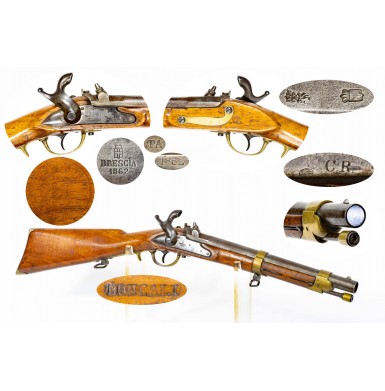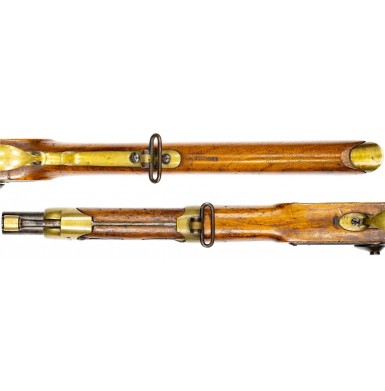Extremely Rare Italian Pistolone da Falegnami di Infanteria Modello 1860 - Infantry Carpenters Pistol Model 1860
- Product Code: FLA-3645-SOLD
- Availability: Out Of Stock
-
$1.00
Offered here is an extremely rare Italian Brescia Arsenal produced Piedmontese pattern Pistolone da Falegnami di Infanteria Modello 1860, which translates to Infantry Carpenters' Pistol Model 1860. These somewhat unique little percussion carbines were in fact considered “pistols” by the Italian military. The gun was adopted for much the same reason the M1 Carbine was adopted by the US military during World War II; it provided more firepower than a pistol but was not as heavy and ungainly a weapon as a full-length rifle or musket for a soldier whose main occupation was construction rather than combat. The weapon was initially adopted by the Kingdom of Piedmont-Sardinia in 1845, prior to the Italian unification circa 1859-1861. The improved Model 1860 was adopted the process of the unification of the various Italian states. The guns then remained in service and production at Italian Arsenals for several more years.
The Infantry Carpenters' Pistol Model 1860 was based upon the earlier Infantry Carpenters' Pistol Model 1845 which itself was a modification of the slightly earlier Pistolone da Cavalleria Modello 1843; Cavalry Pistol Model 1843. The weapons were designed as a true compromise in an attempt to provide something more than a pistol, which could still be used one handed if necessary, yet still had some of the potential range and power of a carbine. The need for such a weapon originated in 1836 when the 6th Cavalry Regiment was rearmed with lances and at the same time turned in their dragoon muskets. This left only a single shot flintlock pistol in their arsenal for a firearm. In the quest to adopt a solution that would be able to fill all the potential firearm needs for the cavalry, the decision was taken to adopt a scaled-down, fixed stock carbine that could be utilized as a pistol as well. The traditional European solution for this type of weapon had been the “pistol carbine”, an oversized pistol with a detachable buttstock, which allowed use as either type of weapon. However, such designs were usually very poor compromises, as the pistol was typically awkward and unbalanced with an overly long, muzzle heavy barrel. Additionally, the use of the gun as a carbine with the detachable shoulder stock was often equally awkward. The resulting carbine was often heavy, the stock rarely attached solidly enough not to wobble and the mating of the two pieces on horseback could be problematic at best. The solution seemed to be the scaling down of the weapon and making the stock a permanent attachment. This made the weapon lighter than the two-piece variant, resulted in a solid buttstock without wobble and allowed the butt to counterbalance the longer, heavier muzzle when used one-handed. The cavalry “carbine” was 27.5” in overall length with a 13.5” barrel with a 16.9mm (about .665” caliber) rifled bore and a Delvigne chamber in the breech. The barrel was secured to the stock with a screw through the breech plug tang and a single combination barrel band and nosecap at the end of the half-length forend. The lockplate was a pistol sized flint style one with a pointed tail, but was produced in percussion, making it one of the first of the Italian states’ percussion arms. The breech was of the patent breech style, giving the gun the appearance of being a percussion alteration, although it was not. The rear of the triggerguard plate included a finger spur that served as a rudimentary supporting pistol grip when the gun was fired one-handed. The gun included a sling ring in the rear of the triggerguard tang, along the toe line of the stock, and a belt hook mounted horizontally along the obverse of the buttstock. There was no provision for retaining a ramrod in the half-length forend, so the ramrods were carried separately. The gun was certainly the inspiration for the much better known Austrian Model 1851 Cavalry Carbine that was adopted a little over a decade later, and which is well known to Civil War arms collectors as many of those Austrian carbines were imported during the Civil War.
In 1845, the Kingdom of Piedmont-Sardinia adopted the direct predecessor of the weapon offered here, the Model 1845 Infantry Carpenters’ Pistol. The gun was a slightly modified version of the M1843 Cavalry Pistol. Most notably, the M1845 Carpenters’ Pistol was fully stocked to within 1.5” of the muzzle, rather than being half-stocked and included a ramrod. The barrel was secured by two bands, one about half-way between the lock and the muzzle and the other a combination nose-cap and upper band. Both bands were flat and retained by band springs. The belt hook was also eliminated from the obverse butt of the Carpenters’ pistol. A pair of sling swivels were added to the gun, one replacing the sling ring in the rear of the triggerguard tang and the other on the bottom of the lower band. Like the cavalry carbine the Carpenters’ pistol was 27.5” in overall length with a 13.5” barrel with a 16.9mm (about .665” caliber) bore. Like the cavalry model, the bores were rifled with eight grooves and a Delvigne breech was incorporated in the design. In 1860, the Carpenters’ Pistol was upgraded with a four-groove rifled bore and the caliber was increased to 17.5mm (.69 caliber), utilizing expanding base conical ammunition. Both variants were brass mounted and had the percussion bolsters and hammers that were of the classic Piedmontese pattern as introduced with their Model 1844 Musket, another gun that is well known to the collector of Civil War arms. In 1860, with the universal adoption of rifled arms and expanding base ammunition the Model 1844 Piedmontese Musket was upgraded with four-groove rifling and a fixed rear sight attached to the breech plug tang via a screw. This produced what collectors have always referred to as the Piedmontese Model 1844/60 Rifled Musket. This same upgrade was applied to the Carpenters’ “Pistols”, creating for all practical purposes the Model 1845/60 for upgraded arms and the Model 1860 for those arms produced in the nominally .70 caliber rifled configuration without having been upgraded.
The Italian Pistolone da Falegnami di Infanteria Modello 1860 (Infantry Carpenters' Pistol Model 1860) offered here is in about FINE overall condition. The gun is 100% complete, correct and original in all respects. Nineteenth century percussion military arms from Italy are extremely scarce in the United States and are rarely found for sale. The 27.5” pistol carbine is clearly marked on the lock in three lines with a {Crown}/{Cross in a Shield} over BRESCIA and 1862. These are the marks and of the Italian Royal Arsenal in Brescia and indicate the gun was produced in 1862. The flat bolster is marked TA and the right barrel flat has the matching date 1862. The “TA” mark suggests the barrel was produced at the Italian Royal Arsenal at Torino (Turin). The left angled breech flat bears the crowned cypher of Italian monarch Vittorio Emmanuelle II, who ruled the Kingdom of Piedmont-Sardinia from 1849 to March 17, 1861, at which point he became the monarch of the unified Italy which he ruled until his death in 1878. The angled breech also shows the Royal Arsenal {Crown}/{Cross in a Shield} marking. The left flat is stamped with a tiny {Crown}/BG and a larger CR. The initials BG are found on the reverse of the lower band in an oval and on the tang of the buttplate. These are either inspection or contractor markings. The obverse of the upper band is stamped with a {Crown}/LG, and the toe of the stock is stamped with what appears to read BONCALI, again a likely contractor. A weak Brescia Arsenal storekeepers’ roundel is present in the obverse buttstock, with the date 1862 in its center.
The gun remains mechanically excellent with a crisp lock that works perfectly on all positions. Like most European percussion arms of the period, the half-cock is a safety notch that is just above the cone, allowing the hammer to keep the cap from falling off the cone. This meant the hammer had to be brought to full cock to prime the gun and the hammer then lowered to half cock for the safety position. The bore of the gun is in about GOOD condition. It has been bored smooth and measures about .73” caliber now, rather than the nominal .69-.70 caliber when it was originally produced. The bore shows scattered moderate oxidation and discoloration and some light pitting. The metal has a lightly oxidized brownish patina over a dull gray steel with some evenly distributed minor pinpricking and peppering present. The lock is smooth with some mottled brown oxidation over dull gray metal as well. All markings in the metal remain clear and legible with the lock markings being particularly crisp. The brass furniture has a lovely, uncleaned mustard patina that is very attractive. The gun retains its original screw-attached fixed rear sight, mounted on the breech plug tang, as well as its original front sight blade. It also retains both of its original sling swivels. The original ramrod is in place as well, with the Spanish style brass band around the tip of the ramrod. It is full-length but was never threaded for cleaning accessories as many rods of the period were. The stock rates about VERY GOOD+ to NEAR FINE, with only a small chip of wood missing from the toe keeping the stock from being “fine”. The stock remains crisp with no indications of having been sanded. The storekeepers’ mark in the butt appears weak only due to wear. The wood is solid, full-length and free of any breaks, cracks or repairs. However, there are scattered bumps, dings and mars present, the typical result of handling and use over a lifetime of more than 150 years.
Overall this is a really wonderful condition and very attractive example of an extremely scarce Italian Brescia Arsenal made Piedmontese pattern Pistolone da Falegnami di Infanteria Modello 1860. As noted earlier, any Italian percussion military arm is extremely rare item outside of Europe and specialty arms like this are extremely scarce. I don’t know when another one of these will come to market, but I rather doubt it will be any time soon. This would be an interesting addition to any collection of European percussion military arms and would be an interesting juxtaposition to display with a Piedmontese Model 1844/60 Rifled Musket. Don’t miss your chance to add this great displaying little carbine to your collection, as you might not get another chance to buy one.
SOLD
Tags: Extremely, Rare, Italian, Pistolone, da, Falegnami, di, Infanteria, Modello, 1860, Infantry, Carpenters, Pistol, Model, 1860















